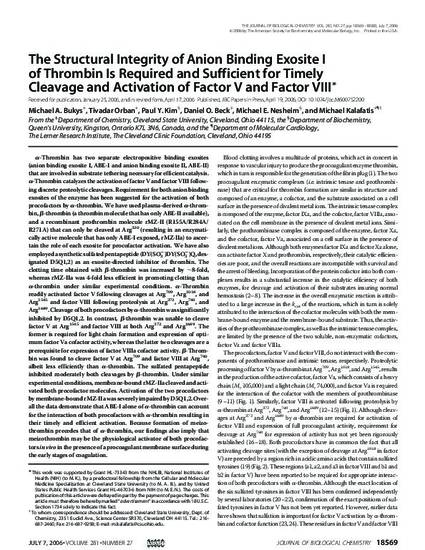
Alpha-thrombin has two separate electropositive binding exosites (anion binding exosite I, ABE-I and anion binding exosite II, ABE-II) that are involved in substrate tethering necessary for efficient catalysis. Alpha-thrombin catalyzes the activation of factor V and factor VIII following discrete proteolytic cleavages. Requirement for both anion binding exosites of the enzyme has been suggested for the activation of both procofactors by alpha-thrombin. We have used plasma-derived alpha-thrombin, beta-thrombin (a thrombin molecule that has only ABE-II available), and a recombinant prothrombin molecule rMZ-II (R155A/R284A/R271A) that can only be cleaved at Arg(320) (resulting in an enzymatically active molecule that has only ABE-I exposed, rMZ-IIa) to ascertain the role of each exosite for procofactor activation. We have also employed a synthetic sulfated pentapeptide (DY(SO(3)(-))DY(SO(3)(-))Q, designated D5Q1,2) as an exosite-directed inhibitor of thrombin. The clotting time obtained with beta-thrombin was increased by approximately 8-fold, whereas rMZ-IIa was 4-fold less efficient in promoting clotting than alpha-thrombin under similar experimental conditions. Alpha-thrombin readily activated factor V following cleavages at Arg(709), Arg(1018), and Arg(1545) and factor VIII following proteolysis at Arg(372), Arg(740), and Arg(1689). Cleavage of both procofactors by alpha-thrombin was significantly inhibited by D5Q1,2. In contrast, beta-thrombin was unable to cleave factor V at Arg(1545) and factor VIII at both Arg(372) and Arg(1689). The former is required for light chain formation and expression of optimum factor Va cofactor activity, whereas the latter two cleavages are a prerequisite for expression of factor VIIIa cofactor activity. Beta-thrombin was found to cleave factor V at Arg(709) and factor VIII at Arg(740), albeit less efficiently than alpha-thrombin. The sulfated pentapeptide inhibited moderately both cleavages by beta-thrombin. Under similar experimental conditions, membrane-bound rMZ-IIa cleaved and activated both procofactor molecules. Activation of the two procofactors by membrane-bound rMZ-IIa was severely impaired by D5Q1,2. Overall the data demonstrate that ABE-I alone of alpha-thrombin can account for the interaction of both procofactors with alpha-thrombin resulting in their timely and efficient activation. Because formation of meizothrombin precedes that of alpha-thrombin, our findings also imply that meizothrombin may be the physiological activator of both procofactors in vivo in the presence of a procoagulant membrane surface during the early stages of coagulation.
Available at: http://works.bepress.com/michael_kalafatis/31/
